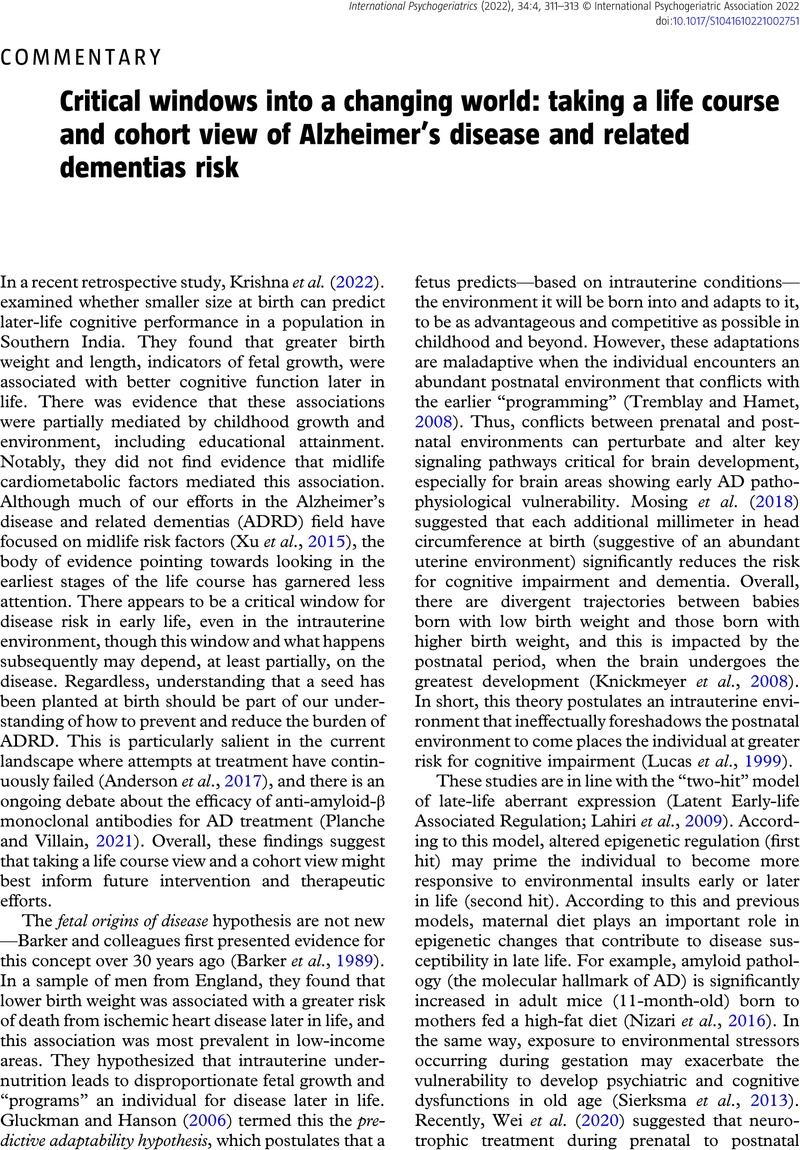No CrossRef data available.
Article contents
Critical windows into a changing world: taking a life course and cohort view of Alzheimer’s disease and related dementias risk
Published online by Cambridge University Press: 11 May 2022
Abstract
An abstract is not available for this content so a preview has been provided. Please use the Get access link above for information on how to access this content.

- Type
- Commentary
- Information
- International Psychogeriatrics , Volume 34 , Issue 4: Issue Theme: Varied Facets of Dementia , April 2022 , pp. 311 - 313
- Copyright
- © International Psychogeriatric Association 2022
References
Anderson, R. M., Hadjichrysanthou, C., Evans, S. and Wong, M. M. (2017). Why do so many clinical trials of therapies for Alzheimer’s disease fail? Lancet, 390, 2327–2329.10.1016/S0140-6736(17)32399-1CrossRefGoogle ScholarPubMed
Arango, C. etal. (2021). Risk and protective factors for mental disorders beyond genetics: an evidence-based atlas. World Psychiatry, 20, 417–436.10.1002/wps.20894CrossRefGoogle ScholarPubMed
Barker, D. J., Winter, P. D., Osmond, C., Margetts, B. and Simmonds, S. J. (1989). Weight in infancy and death from ischaemic heart disease. Lancet, 2, 577–580.CrossRefGoogle ScholarPubMed
Gluckman, P. D. and Hanson, M. A. (2006). The consequences of being born small - an adaptive perspective. Hormone Research in Paediatrics, 65, 5–14.CrossRefGoogle Scholar
Herzberg, M. P. and Gunnar, M. R. (2020). Early life stress and brain function: activity and connectivity associated with processing emotion and reward. Neuroimage, 209, 116493.CrossRefGoogle ScholarPubMed
Howerton, C. L. and Bale, T. L. (2012). Prenatal programing: at the intersection of maternal stress and immune activation. Hormones and Behaviour, 62, 237–242. doi: 10.1016/j.yhbeh.2012.03.007.CrossRefGoogle ScholarPubMed
Knickmeyer, R. C. etal. (2008). A structural MRI study of human brain development from birth to 2 years. Journal of Neuroscience, 28, 12176–12182.CrossRefGoogle ScholarPubMed
Krishna, M. etal. (2022). Size at birth, lifecourse factors, and cognitive function in late life: findings from the MYsore study of Natal effects on Ageing and Health (MYNAH) cohort in South India. International Psychogeriatrics, 34, 353–366. doi: 10.1017/S1041610221001186.Google Scholar
Lahiri, D. K., Maloney, B. and Zawia, N. H. (2009). The LEARn model: an epigenetic explanation for idiopathic neurobiological diseases. Molecular Psychiatry, 14, 992–1003.10.1038/mp.2009.82CrossRefGoogle ScholarPubMed
Liu, S., Jones, R. N. and Glymour, M. M. (2010). Implications of lifecourse epidemiology for research on determinants of adult disease. Public Health Reviews, 32, 489–511.10.1007/BF03391613CrossRefGoogle ScholarPubMed
Lucas, A., Fewtrell, M. S. and Cole, T. J. (1999). Fetal origins of adult disease-the hypothesis revisited. BMJ, 319, 245–249.CrossRefGoogle ScholarPubMed
Mitchell, E. etal. (2016). Behavioural traits propagate across generations via segregated iterative-somatic and gametic epigenetic mechanisms. Nature Communications, 7, 11492.10.1038/ncomms11492CrossRefGoogle ScholarPubMed
Moceri, V. M. etal. (2001). Using census data and birth certificates to reconstruct the early-life socioeconomic environment and the relation to the development of Alzheimer’s disease. Epidemiology, 12, 383–389.CrossRefGoogle Scholar
Mosing, M. A., Lundholm, C., Cnattingius, S., Gatz, M. and Pedersen, N. L. (2018). Associations between birth characteristics and age-related cognitive impairment and dementia: a registry-based cohort study. PLoS Medicine, 15, e1002609.CrossRefGoogle ScholarPubMed
Nizari, S., Carare, R. O. and Hawkes, C. A. (2016). Increased Aβ pathology in aged Tg2576 mice born to mothers fed a high fat diet. Scientific Reports, 6, 21981.10.1038/srep21981CrossRefGoogle ScholarPubMed
Pini, L., Wennberg, A. M., Salvalaggio, A., Vallesi, A., Pievani, M. and Corbetta, M. (2021). Breakdown of specific functional brain networks in clinical variants of Alzheimer’s disease. Ageing Research Reviews, 72, 101482.CrossRefGoogle ScholarPubMed
Planche, V. and Villain, N. (2021). US Food and Drug Administration Approval of Aducanumab—Is Amyloid Load a Valid Surrogate End Point for Alzheimer Disease Clinical Trials? JAMA Neurology, 78, 1307–1308.CrossRefGoogle ScholarPubMed
Roseboom, T., de Rooij, S. and Painter, R. (2006). The Dutch famine and its long-term consequences for adult health. Early Human Development, 82, 485–491.CrossRefGoogle ScholarPubMed
Seifan, A., Schelke, M., Obeng-Aduasare, Y. and Isaacson, R. (2015). Early life epidemiology of Alzheimer’s disease--A critical review. Neuroepidemiology, 45, 237–254.CrossRefGoogle ScholarPubMed
Sierksma, A. S. etal. (2013). Behavioral and neurobiological effects of prenatal stress exposure in male and female APPswe/PS1dE9 mice. Neurobiology of Aging, 34, 319–337.10.1016/j.neurobiolaging.2012.05.012CrossRefGoogle ScholarPubMed
Toth, M. (2015). Mechanisms of non-genetic inheritance and psychiatric disorders. Neuropsychopharmacology, 40, 129–140.CrossRefGoogle ScholarPubMed
Tremblay, J. and Hamet, P. (2008). Impact of genetic and epigenetic factors from early life to later disease. Metabolism, 57, S27–S31.CrossRefGoogle ScholarPubMed
Wei, W. etal. (2020). Prenatal to early postnatal neurotrophic treatment prevents Alzheimer-like behavior and pathology in mice. Alzheimer’s Research & Therapy, 12, 102.10.1186/s13195-020-00666-7CrossRefGoogle ScholarPubMed
WHO (2014). Global Nutrition Targets 2025: Low Birth Weight Policy Brief (WHO/NMH/NHD/14.5). Geneva: World Health Organization.Google Scholar
Xu, W. etal. (2015). Meta-analysis of modifiable risk factors for Alzheimer’s disease. Journal of Neurology, Neurosurgery & Psychiatry, 86, 1299–1306.Google ScholarPubMed
Yehuda, R., Bell, A., Bierer, L. M. and Schmeidler, J. (2008). Maternal, not paternal, PTSD is related to increased risk for PTSD in offspring of Holocaust survivors. Journal of Psychiatric Research, 42, 1104–1111.CrossRefGoogle Scholar




